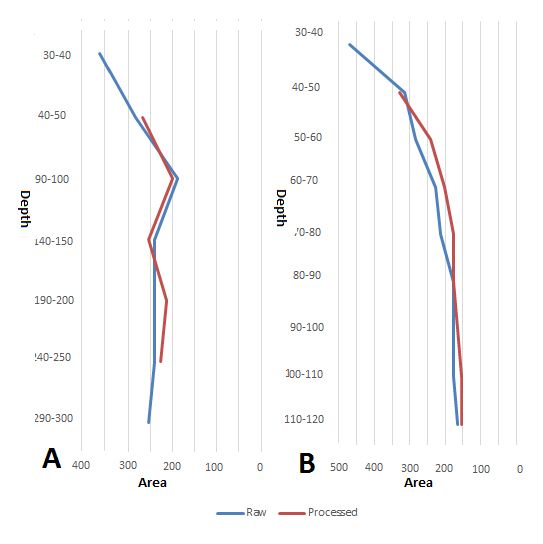Cite this as: Gaffney, V. et al. 2020 A Massive, Late Neolithic Pit Structure associated with Durrington Walls Henge, Internet Archaeology 55. https://doi.org/10.11141/ia.55.4
Estimating the volume of the pits at Durrington Walls is inherently problematic. There is clearly variation in the diameter of recorded pits, which range from 10 to 23m, and with an average of 17m. Where the upper levels have been excavated there has been a weathering cone at the top of each feature, and this seems to be replicated within the GPR profiles. Figure 8.1 demonstrates that the pit walls are relatively steeply inclined towards the surface and the area of the pits within GPR time slices declines to c.50% or less of the anomaly area. Following this the walls are nearly vertical until they cannot be resolved within the GPR data. The partly excavated pit 14D also suggests the sides of some features may narrow with depth and this particular example tapered to c.7m diameter at 3m depth (Thompson and Powell 2018, 15-16). Given the size of the pits, the lack of excavation and reliance on small corers to recover depth data, there is no certainty that deeper shafts do not exist within the pits

The relative conformity of the pit group suggests that modelling the volume of an average pit may be insightful in respect of the relative investment of effort into digging these massive features.
A conservative figure for the volume of a hypothetical pit can be derived using the formula for a conical frustrum (Wolfram Mathworld nd). Three values can be derived from the available data for a pit with an average diameter of 17m.
The formula for the conical frustrum provides a volume of a pit with r1 = 4.25, r2 = 4.25 and h= 5 would then be 283 cubic metres.
The volume of the 20 known features might therefore be as much as 5360 cubic metres.
This figure is based on known features rather than the actual number of dug features. Some 40% or more of the hypothetical pit circuit, conservatively measured from the river terraces above the Avon, has either not been surveyed or is now unavailable for inspection. Pro rata, there may have been another 13 pits and the total number of pits 33 or more.
The volume of chalk extracted from up to 33 hypothetical pits may have been in the order of 9339 cubic metres.
In comparison, the volume of material estimated to be contained within the bank at Durrington Walls by Wainwright and Longworth (1971, 196) may have been c.49604 cubic metres. This figure is equivalent to the fill of c.175 hypothetical pits. The volume of the hypothetical circuit of 33 pits suggests that the volume of extracted chalk might have been equivalent to as much as 18% of the bank material at Durrington Walls.
Internet Archaeology is an open access journal based in the Department of Archaeology, University of York. Except where otherwise noted, content from this work may be used under the terms of the Creative Commons Attribution 3.0 (CC BY) Unported licence, which permits unrestricted use, distribution, and reproduction in any medium, provided that attribution to the author(s), the title of the work, the Internet Archaeology journal and the relevant URL/DOI are given.
Terms and Conditions | Legal Statements | Privacy Policy | Cookies Policy | Citing Internet Archaeology
Internet Archaeology content is preserved for the long term with the Archaeology Data Service. Help sustain and support open access publication by donating to our Open Access Archaeology Fund.